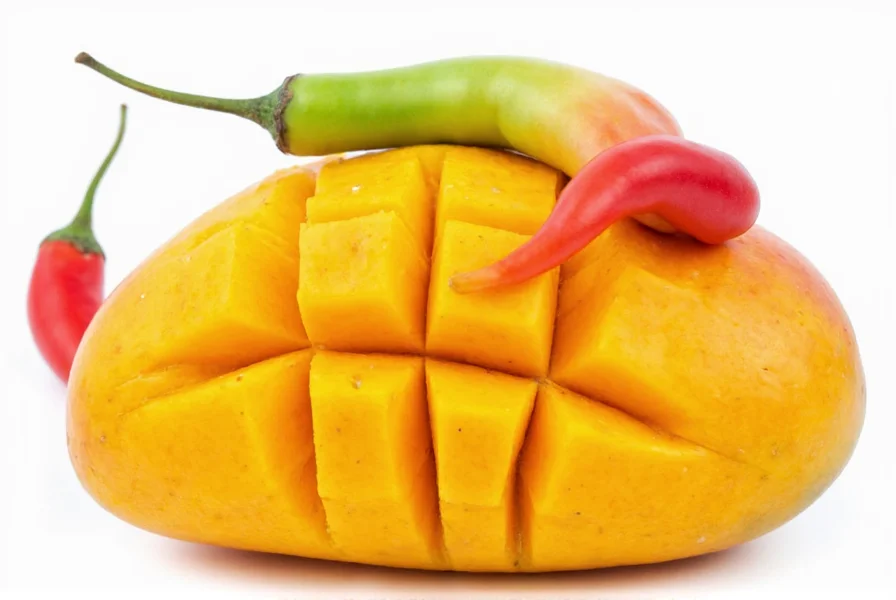For food enthusiasts exploring global flavors, chili mango represents one of the most beloved sweet-heat combinations across multiple culinary traditions. This distinctive pairing has gained international popularity through various snack products and traditional preparations that showcase how complementary these seemingly opposite flavors can be.
The Flavor Science Behind Chili Mango
Understanding why chili mango works requires examining the chemical interaction between its components. Mango contains natural sugars that activate sweet receptors, while capsaicin in chili peppers triggers heat receptors. When combined, these elements create what food scientists call sensory contrast—where opposing sensations enhance each other rather than compete.
"The magic of chili mango lies in its balance," explains Dr. Elena Rodriguez, a food chemist specializing in flavor pairing. "Mango's citric and malic acids cut through the heat, while its sweetness provides immediate relief from capsaicin's burn, creating a satisfying flavor cycle that keeps people reaching for more."

Cultural Origins and Traditional Uses
Chili mango isn't a modern invention but has deep roots in multiple food cultures:
| Cultural Tradition | Preparation Method | Significance |
|---|---|---|
| Mexican | Green mango with chili powder, lime, and salt | Street food staple known as 'mango picosito' |
| Thai | Green mango with fish sauce, chili, and sugar | Traditional snack called 'mamuang nam pla wan' |
| Filipino | Ripe mango with bagoong (shrimp paste) and chili | Common household preparation during mango season |
| Vietnamese | Green mango with salted chili powder | Popular street snack often sold by vendors |
Each culture developed its version independently, demonstrating how naturally these ingredients complement each other. In tropical regions where both mangoes and chili peppers grow abundantly, this pairing emerged as a practical way to enhance seasonal fruit.
Modern Culinary Applications
Today, chili mango appears in diverse food products beyond traditional preparations. Food manufacturers have expanded this flavor combination into numerous categories while maintaining its essential sweet-heat balance.
Chili mango in contemporary cuisine
- Snack foods: Dried mango strips with chili seasoning have become globally popular
- Sauces and condiments: Chili mango salsa pairs well with grilled meats and fish
- Beverages: Mango chili margaritas and craft sodas featuring this flavor profile
- Desserts: Innovative chefs incorporate chili into mango sorbets and tarts
Professional chefs appreciate chili mango's versatility. "It works equally well in sweet and savory applications," notes Chef Marcus Chen, who features chili mango elements in his California-Asian fusion menu. "The key is respecting the balance—too much chili overwhelms the mango, while insufficient heat makes the dish one-dimensional."
Creating Authentic Chili Mango at Home
Reproducing traditional chili mango preparations requires attention to ripeness and seasoning ratios. Here's how to make the classic street-style version:
- Select firm, slightly underripe mangoes for better texture contrast
- Prepare a seasoning blend of chili powder, salt, and lime juice (2:1:1 ratio)
- Cut mango into thin slices or cubes
- Sprinkle seasoning mixture evenly over mango
- Let sit for 5-10 minutes to allow flavors to meld
For those preferring less heat, adjust the chili-to-salt ratio. Some traditional preparations add tamarind for additional complexity. The critical element is maintaining the sweet-heat-sour balance that defines authentic chili mango flavor.

Health Considerations of Chili Mango
This flavor combination offers potential health benefits beyond its taste appeal. Mango provides vitamins A and C, fiber, and antioxidants, while chili peppers contain capsaicin, which has been studied for various health effects.
Research published in the Journal of Food Science indicates that capsaicin may temporarily boost metabolism and provide anti-inflammatory effects. Meanwhile, mango's fiber content helps moderate the sugar impact, making this combination potentially healthier than many sweet snacks.
Nutritionists caution that commercially prepared chili mango snacks sometimes contain added sugar and preservatives. For maximum health benefits, prepare chili mango using fresh ingredients with minimal added components.
Finding Quality Chili Mango Products
When selecting store-bought chili mango items, look for these quality indicators:
- Short ingredient lists with recognizable components
- Mango as the first ingredient (not mango flavoring)
- Natural chili sources rather than artificial flavorings
- No excessive added sugars or preservatives
Artisanal producers often create superior chili mango products compared to mass-market versions. Specialty food stores and international markets typically offer the most authentic options, though quality varies significantly by brand.
FAQs About Chili Mango
What makes chili mango such a popular flavor combination?
Chili mango's popularity stems from the perfect balance between sweet and spicy elements. The natural sugars in mango counteract chili heat while enhancing its flavor complexity. This sensory contrast creates a satisfying eating experience that engages multiple taste receptors simultaneously, making it particularly appealing across diverse palates.
Which type of mango works best for chili mango preparations?
For traditional street-style chili mango, firm, slightly underripe mangoes work best as they provide better texture contrast and balance the heat more effectively. Atapang or Keitt varieties maintain their structure well. For sweeter preparations, ripe Ataulfo or Kent mangoes create a different but equally enjoyable experience with more pronounced sweetness balancing the chili.
Can I make chili mango without artificial flavorings?
Absolutely. Authentic chili mango requires only fresh mango, natural chili powder (like arbol or de árbol), salt, and lime juice. Many commercial products use artificial flavorings, but homemade versions using these simple ingredients create superior flavor and avoid unnecessary additives. The key is using quality chili powder rather than pre-mixed seasoning blends that often contain sugar and preservatives.
Is chili mango suitable for children?
Chili mango can be adapted for children by significantly reducing the chili content. Many cultures introduce this flavor combination to children through mild versions using just a pinch of chili powder. The natural sweetness of mango makes it appealing, while the small amount of heat helps develop more sophisticated palates. Always start with minimal chili and adjust based on individual tolerance.
How does chili mango differ across various cultures?
Cultural variations of chili mango primarily differ in seasoning components and mango ripeness. Mexican versions typically use green mango with chili-lime salt, Thai preparations incorporate fish sauce and palm sugar, Filipino versions sometimes include shrimp paste, and Vietnamese styles emphasize salted chili powder. Despite these differences, all maintain the essential sweet-heat balance that defines the flavor combination.











 浙公网安备
33010002000092号
浙公网安备
33010002000092号 浙B2-20120091-4
浙B2-20120091-4